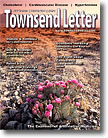| Vitamin
C: The Real Story
by Steve Hickey, PhD, and Andrew W. Saul, PhD
Basic Health Publications, Inc.
28812 Top of the World Drive, Laguna Beach, California 92651
949-715-7327
www.basichealthpub.com
Paperback; ©2008; $18.95; 193 pp.
As detailed by authors Steve Hickey,
PhD, and Andrew Saul, PhD, the medical history of vitamin C reads
like a laundry list of missed opportunities and willful ignorance.
Ever since Albert Szent-Györgyi, MD, PhD, first isolated ascorbic
acid and identified it as "vitamin" C in the late 1920s,
controversy has ensued. By definition, a vitamin is categorized
as a micronutrient, an essential element that human bodies need
in small quantities. But Szent-Györgyi made his classification
before the sweeping notion that all vitamins are micronutrients
took hold, and his evolving suspicion that ascorbic acid is needed
in much larger doses has been shared and strengthened by many other
noteworthy scientists who followed, as Hickey and Saul so ably illustrate.
Here is Irving Stone, PhD, who determined that ascorbic acid was
not "a vitamin at all, but an essential dietary factor"
and first proposed that high doses be given at short intervals.
And Frederick Klenner, MD, known for his remarkable use of treating
polio successfully with megadoses of vitamin C during a 1948 epidemic.
Lendon Smith, MD, risked his reputation when he prescribed megavitamins,
including vitamin C, for children in his groundbreaking 1979 book
Feed Your Kids Right.
At the forefront, of course, was two-time Nobel winner Linus Pauling,
PhD, whose popularization of the need for high-dose vitamin therapy
opened the door to nutritional therapy and lifesaving "orthomolecular
medicine." The list of acclaimed scientists and physicians
who have championed the role of vitamin C in fighting disease is
long – and includes famed orthomolecular pioneer Abram Hoffer,
MD, PhD, who provides a foreword for the book – and yet, despite
the gains and conclusions reached by these august researchers, the
use of vitamin C remains continually fraught with contentious resistance
from the medical establishment, which can’t quite let go of
the "micronutrient" definition.
So, in Vitamin C: The Real Story,
the authors revisit the definition of vitamin C. They make the case
that vitamin C is not a micronutrient needed in trace amounts administered
once a day to stave off diet-induced deficiencies. Instead, they
argue, it is a vital nutrient that cannot be assimilated from even
the best diet in the significantly large amounts needed. When the
quantity of vitamin C consumed is too low, the result is illness.
Scurvy is perhaps the best-known resultant disease, but the authors
argue throughout this book that "almost every chronic disease
has been related to an insufficient intake of vitamin C."
The real meat of this book lies in Chapter 3, "Taking Vitamin
C." Here the authors address the central debate regarding vitamin
C usage: the optimal intake. They look at how and why the Recommended
Dietary Allowance (RDA) – also referred to here as the "ridiculous
dietary allowance" – was wrongly determined, setting
up a seemingly endless battle between those who believe that once
an RDA is established, it’s a "proven," irrevocable
fact, and those who have witnessed the extraordinary results effected
by much higher doses. Most instructively, the authors make their
case by explaining the ins and outs of vitamin C absorption (demonstrating
the need not just for high doses but also divided dosages), detailing
the forms of vitamin C, and debunking warnings about potential side
effects.
Authors Hickey and Saul do not shy away from controversy. They discuss
the limitations created when social medicine models are used to
provide "proof" that ignores or flies in the face of the
"basic sciences of biophysics, biochemistry, and physiology."
They take the medical community to task for its reluctance to look
beyond poorly engineered clinical trials that are not only useless
but also seemingly purposefully stupid. And they even wade into
a burgeoning dispute, dismissing those who promote a "vitamin
C complex" as preferable to the proven effective and simple
ascorbic acid.
In clear, concise language, the authors go on to educate readers
on the need for antioxidants, before taking a closer look at the
use of vitamin C therapies as a central, adjunct, or preventative
treatment for infectious diseases, heart disease, and cancer. Overall,
Vitamin C: The Real Story
is a timely and valuable clarion call that cuts through misleading
blather and making a strong case for the orthomolecular use of vitamin
C.
|



![]()
![]()
![]()

